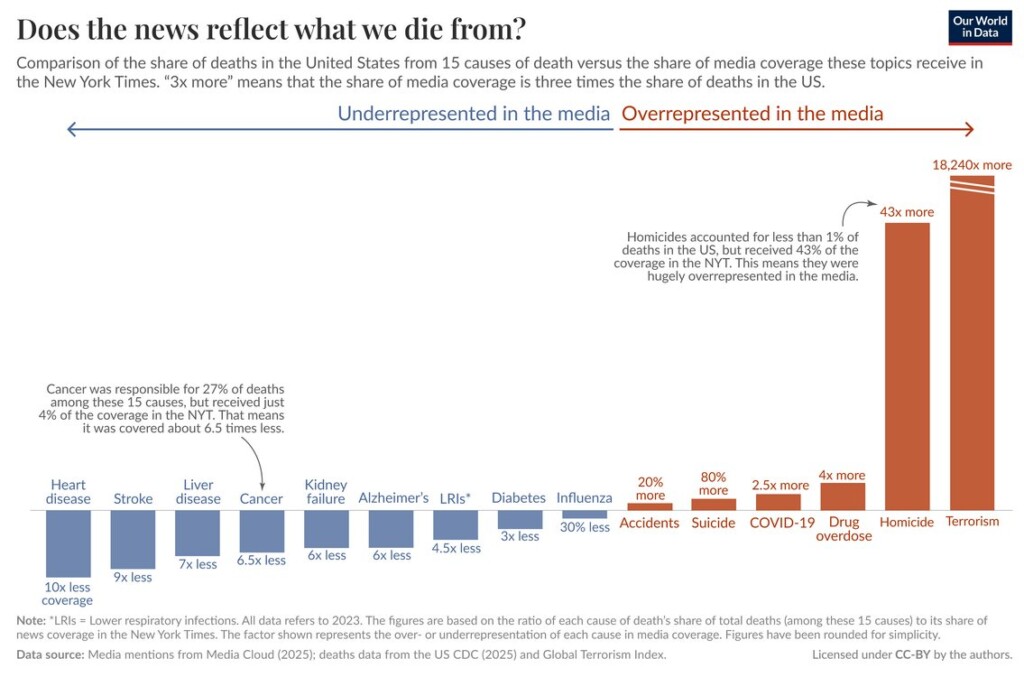 Photo by Muhammad Taha Ibrahima via unsplash
Photo by Muhammad Taha Ibrahima via unsplash
For almost 30 years, GNN has been busting global media’s 24-hour gloom and doom cycle with the premise that bad news doesn’t have to sell, and good news isn’t rare at all.
A case-in-point for this outlet’s publishing mission is a study recently released on Our World in Data that showed how bad news events like murder and terrorism are extraordinarily over-covered by American media.
For example, homicide receives approximately 4,300% more media coverage than its share of deaths across the American population every year.
Put differently, if every death in America was reported on, news stories on homicides would be fewer in number by a factor of 43.
According to the study the same is true for terrorism—by a staggering 18,000 percent.
Relying on Media Cloud, an open-access platform for media analysis, the team behind the study analyzed news headlines covering the 12 most-common causes of death in America, plus homicide, drug overdoses, and terrorism, as these were perceived by the authors to receive an outsized share of media coverage.
The team then gathered news stories from three of the largest news outlets in America: the New York Times, the Washington Post, and the news website of Fox News. Their criteria was set to ensure the stories focused on these causes of death as the topic, rather than in passing.
“Heart disease and cancer accounted for 56% of deaths among these 15 causes, but together they received just 7% of the media coverage,” the study team, consisting of Hannah Ritchie, Tuna Acisu, and Edouard Mathieu, found and wrote in their presentation.
“Rare—but dramatic—events such as homicides and terrorism received more than half of all media coverage,” despite together representing less than 1% of all deaths in America.
 – credit, Ritchie et al on CC-BY License
– credit, Ritchie et al on CC-BY License
Drug overdoses were also overrepresented—by 4-times their share of mortality events in the American population. Suicide was overrepresented by 80%.
“Nearly six-in-ten Americans still see international terrorism as a critical threat to the United States, despite the domestic impact on the US being relatively low for two decades,” the authors write. Indeed, terrorism killed just 16 Americans last year, about half the number of Americans killed in elevator accidents. If you’re not thinking twice about climbing into a rickety elevator, than you probably shouldn’t overly worry about terrorism.
BREAK THE BAD NEWS CYCLE: Instead of ‘We Are What We Eat,’ the Science of Kindness Says ‘We Are What We See’ in Daily Life
It doesn’t appear to be down to a conspiracy in media, but rather because American reporters are just following the absolute basics of ‘storytelling’. Heart disease and cardiovascular events kill 2,000 Americans every day, so the headline would be the same as yesterday’s and the day before that, with little variation.
A dramatic event like a plane crash or a gun battle in an American downtown area, has eye-witnesses, dramatic recounting, and enough individual details to make a story.
MORE POSITIVE HEADLINES: Five Top Headlines that Showcase the World’s Progress in the Climate Fight
Ritchie, Acisu, and Mathieu write that the vast majority of news consumers cite a motivation to be better informed, and to keep track of what’s happening in the world, as the reasons for their attention to the news.
Even though it’s clear that the number of news stories on a topic doesn’t actually reflect the overall state of a society, it’s easy to fall into the trap of thinking it does, and feel depressed because you’re led to believe life is full of malicious, despairing savagery.
SHARE This Perspective Shifting News With Your Friends On Social Media…

